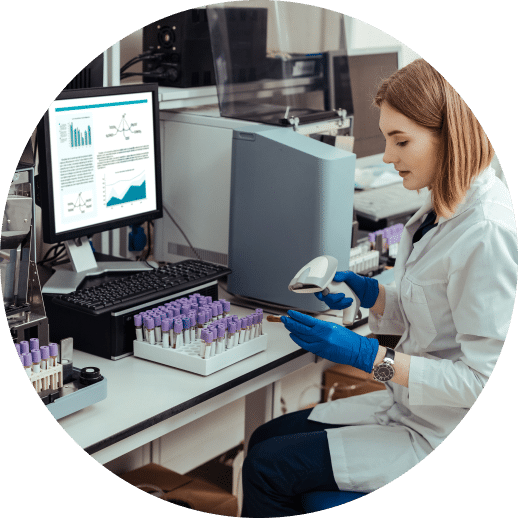Clinical Indication ID & Name
Monogenic diabetes
Test Group
Endocrinology
Specialties
Test code
R141.1
Test name
N/A
Target genes
Monogenic diabetes (472)
Test scope
n/a
Test method/ technology
WES or Medium Panel
Optimal Family Structure
n/a
Eligibility Criteria
1. Patients with isolated diabetes should be tested if they have:
a. Diabetes diagnosed young (≤35 years in White Europeans and ≤30 years in high prevalence ethnic groups).
AND
b. Unlikely to have Type 1 diabetes because:
They are not on insulin treatment.
OR
They are on insulin treatment with all autoantibodies tested negative (minimum testing of GADA and IA2A) and a random non-fasting C peptide value ≥200pmol/l
AND
c. Have features suggestive of MODY:
An HbA1c at diagnosis of diabetes <7.5% (58mmol/mol), if diagnosed under 18 years of age,
OR
BMI <30kg/m2 adult (child BMI <95th centile) and a parent with diabetes (if White) or BMI <27kg/m2
(child BMI <95th centile) and a parent with diabetes (if high prevalence type 2 diabetes ethnic group).
OR
Have a MODY probability score ≥20% if not insulin treated and ≥10% if insulin treated (see https://www.diabetesgenes.org/exeter-diabetes-app/ModyCalculator)
2. Syndromic diabetes: Patients with diabetes AND non-autoimmune extra-pancreatic features
• Diabetes diagnosed young
AND
• Unlikely to have type 1 diabetes (see 1b) or type 2 diabetes.
AND
• Non-autoimmune extra pancreatic features suggestive of syndromic monogenic diabetes
e.g.
• Cystic renal disease and/or congenital anomaly of kidney or urinary tract
• Bilateral sensorineural deafness
• Developmental delay
• Developmental defects
• Cardiomyopathy
• Optic atrophy
• Microcephaly
3. Diabetes with severe insulin resistance
• Patients have features of severe insulin resistance in the absence of obesity:
• Acanthosis nigricans
OR
• A fasting insulin >150pmol/l if not insulin treated OR if insulin treated an insulin requirement >3U/kg/day
AND
• Diabetes that is unlikely to be type 1 diabetes (see 1.0 above) or type 2
diabetes (BMI<30kg/m2 if white (<95th in children) or BMI <27kg/m2 (<95th in children) if high prevalence type 2 diabetes group).
Test code
R141.2
Test name
N/A
Target genes
GCK;HNF1A;HNF4A;HNF1B
Test scope
n/a
Test method/ technology
MPLA or equivalent
Optimal Family Structure
n/a
Eligibility Criteria
1. Patients with isolated diabetes should be tested if they have:
a. Diabetes diagnosed young (≤35 years in White Europeans and ≤30 years in high prevalence ethnic groups).
AND
b. Unlikely to have Type 1 diabetes because:
They are not on insulin treatment.
OR
They are on insulin treatment with all autoantibodies tested negative (minimum testing of GADA and IA2A) and a random non-fasting C peptide value ≥200pmol/l
AND
c. Have features suggestive of MODY:
An HbA1c at diagnosis of diabetes <7.5% (58mmol/mol), if diagnosed under 18 years of age,
OR
BMI <30kg/m2 adult (child BMI <95th centile) and a parent with diabetes (if White) or BMI <27kg/m2
(child BMI <95th centile) and a parent with diabetes (if high prevalence type 2 diabetes ethnic group).
OR
Have a MODY probability score ≥20% if not insulin treated and ≥10% if insulin treated (see https://www.diabetesgenes.org/exeter-diabetes-app/ModyCalculator)
2. Syndromic diabetes: Patients with diabetes AND non-autoimmune extra-pancreatic features
• Diabetes diagnosed young
AND
• Unlikely to have type 1 diabetes (see 1b) or type 2 diabetes.
AND
• Non-autoimmune extra pancreatic features suggestive of syndromic monogenic diabetes
e.g.
• Cystic renal disease and/or congenital anomaly of kidney or urinary tract
• Bilateral sensorineural deafness
• Developmental delay
• Developmental defects
• Cardiomyopathy
• Optic atrophy
• Microcephaly
3. Diabetes with severe insulin resistance
• Patients have features of severe insulin resistance in the absence of obesity:
• Acanthosis nigricans
OR
• A fasting insulin >150pmol/l if not insulin treated OR if insulin treated an insulin requirement >3U/kg/day
AND
• Diabetes that is unlikely to be type 1 diabetes (see 1.0 above) or type 2
diabetes (BMI<30kg/m2 if white (<95th in children) or BMI <27kg/m2 (<95th in children) if high prevalence type 2 diabetes group).
Commissioning group
Specialised
Overlapping idications
• R158 Lipodystrophy – childhood onset test should be used for congenital severe syndromic forms of lipodystrophy • R142 Glucokinase-related fasting hyperglycaemia test should be used for asymptomatic fasting hyperglycaemia
Address for samples/request forms
Please refer to the test request form.
Contact with queries
Supporting documents
n/a
Education resources
n/a
Service updates
n/a
Request form download
Form not available, please contact us to enquire.
Form not available, please contact us to enquire.
Consent record
See consent guidance in test request form
Sample requirements
Sample Requirements Each sample must be sent labelled with 3 patient identifiers and must state the sample type clearly on the sample container. Sample Rejection Samples may be rejected for the following reasons: 1. Samples and request form do not show at least three identical patient identifiers 2. The sample is in the incorrect collection media 3. The request form is not sufficiently completed 4. The sample is not of sufficient volume 5. The sample is too old Sample Storage and Volume Required: Perirpheral blood in an EDTA tube: Adult and children 4 ml, Infants (0-2 years) 1 ml or a DNA sample (3-5µg of purified DNA). Where it is not possible to collect peripheral blood we will accept a saliva sample (please contact the lab for specific details). Storage, sample packing and transportation: Blood should be stored at 4°C where possible. Send at room temperature by first class post or by courier. Patient/Clinician Instructions: N/A Factors affecting performance of test/interpretation of results: Clotted samples are unsuitable for DNA analysis. Blood Samples in incorrect anticoagulant tubes may be rejected.
